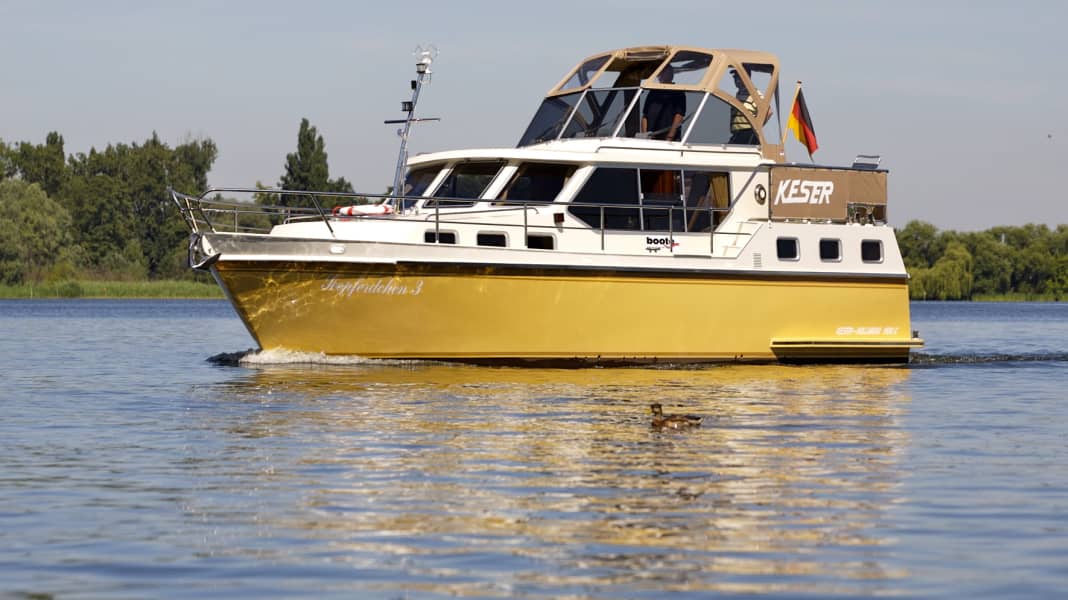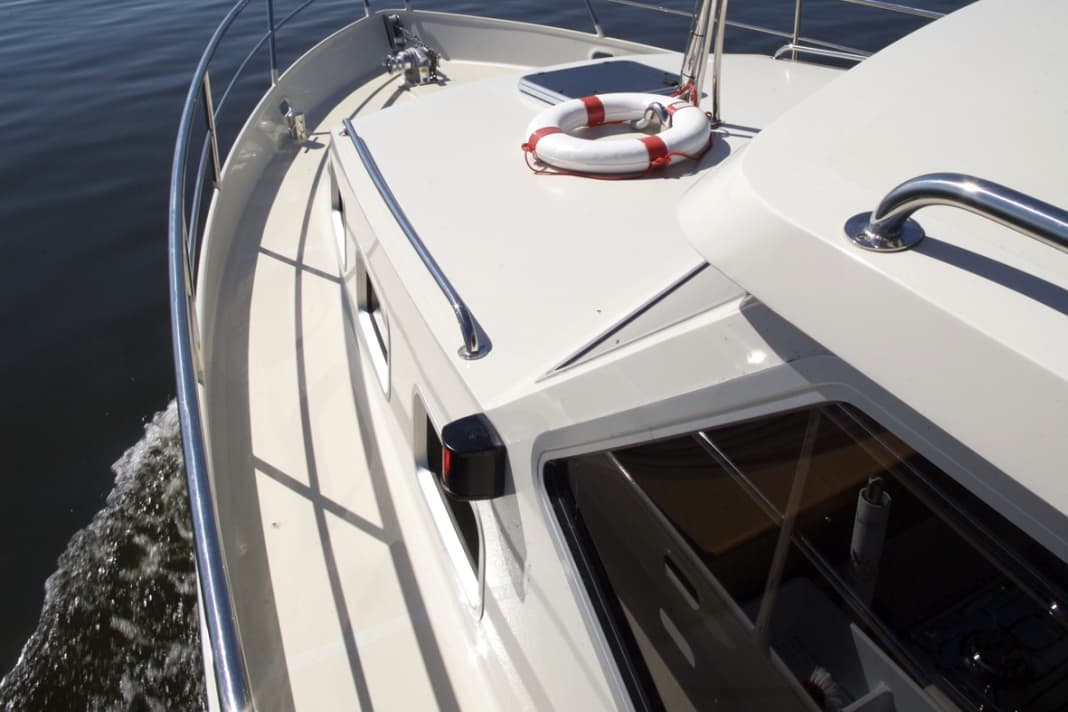






Boat building and charter business in one - a concept that has brought success to Bootscenter Keser in Berlin. Keser has been manufacturing its own Hollandia brand for over 30 years. The steel yachts between 9.50 and 12.00 metres are produced by the Keser family business in the Netherlands. We sailed the Hollandia 1100 C, which is exactly 11.00 metres long. The "C" stands for the indication that this is the charter version. If, on the other hand, the boat has the suffix "S", we are dealing with the owner's version. The biggest differences to our charter test version are as follows: only one wet area, a second driving position in the saloon and the galley further forward. "Special requests can easily be accommodated," says junior boss Mike Keser. "The customer can plan and coordinate the hull extension individually with us."
Our test boat is designed for optimal use with several people. This means a cabin aft with a double berth, en-suite shower and WC as well as a bow cabin with a double berth and additional wet areas. In the centre is the saloon with galley and convertible seat/berth combination. The boat is only sailed from the cockpit. The skipper does this from a suitably upholstered 1 ½-person bench seat. As the bench is free-standing, a suitable seating position can be found for (almost) any size of rider, from which the steering wheel and gearstick (which got stuck when we were travelling ahead) are within easy reach. Disadvantage in rough seas: the bench moves quickly and offers little support. In this situation, it's best to stand up and balance out the swell with your legs and body.
The shipyard installed large foil windows in the convertible top so that you have a good view forwards not only when sitting but also when standing. In the lower area, a folding, three-part windscreen (safety glass) mounted in a solid aluminium frame protects the passengers. Three double-arm windscreen wipers provide the necessary visibility in rain and splash water. No defroster or windscreen washer system.
The instruments are easy to read in all driving positions. Toggle switches with symbols and indicator lights are located far forward on the instrument panel. When seated, you have to lean far forward to operate them. The Volkswagen Marine panel with the starter key, which brings the five-cylinder TDI engine with 120 hp to life, is easier to reach. If you let it rev at 1000 rpm, the Hollandia runs at 3.7 knots and consumes 0.54 l/sm; one tank of fuel minus 15% reserve is then enough for 1466 nm.
cruising speed is just under 7 kn (2200 rpm), and the range is calculated at 1.17 l/sm, a respectable
363 nm. From 3000 rpm onwards, the stern wave picks up strongly. If you push the lever all the way forwards, you can make progress at 8.6 kn, consumption is then a generous 2.89 l/sm, and the range shrinks to 147 nm. The noise level remains in the "humane range" at 73 dB/A under full load. At 2000 rpm, however, our test Hollandia produces an annoying whistling noise.
If you make tight turns at high speed, you only need to be prepared for the boat to lean slightly to the side on the inside of the turn and for it to rock slightly in its own wave. The turning circles at slow speed are between 1 ½ and 2 boat lengths. Turning from starboard to port is only possible with a short interception, but it works directly in the other direction. On our test boat, the manufacturer installed bow and stern thrusters (both extra), which even inexperienced skippers can use to dock the boat without panicking.
The waves of our test area were only low, which does not allow an objective statement about the rough water behaviour of the hull.
The engine compartment, on the other hand, was easy to check as it is easily accessible via two flaps (with openers, like the car bonnet) in the saloon floor. The technician has plenty of space in the engine compartment to carry out service and repair work. The boat builders laid most of the cables and hoses neatly in cable ducts. They only used a screw clamp to connect the diesel hoses. The fuel is cleaned by a Vetus filter cartridge with a drain plug, but without an electrical alarm. The filling caps of the fuel, fresh water and waste water tanks are labelled by the shipyard in accordance with regulations.
The batteries are in plastic boxes with lids and retaining straps. The corresponding main switches are conveniently located under the saloon bench. Vending machines can be found on a switch panel at the companionway to the saloon.
In the latter there is a well-equipped galley block and a seating area which, together with two free-standing stools, offers sufficient space for six people.
The bench seat can be converted into a bunk, but the main sleeping areas are located in the front and rear cabins. Both offer soft cushions that are suitable for lying down, but are not ventilated. Cabin ventilation is provided by portholes and escape hatches, while portholes also ensure a good supply of fresh air in the sufficiently large heads compartments. As is usual on a charter version, there are good stowage facilities throughout the boat.
The Keser crew has equipped the cockpit with free-standing furniture, so the design can be freely chosen. The fixed bathing platform with a folding bathing ladder, whose extension serves as a descent to the bathing platform, is a different matter. The shipyard has fitted the platform with non-slip structures just like the entire cockpit, side deck and foredeck. Handrails and railings also ensure safe movement.
The standard safety equipment includes three electric bilge pumps, but the important manual bilge pump, which also works in the event of a power failure, is missing. The shipyard provides two 2-kg fire extinguishers for firefighting.
If you study the list of accessories, you will find important and practical items such as a 12 V/30A charger, heater, rudder indicator, navigation instruments, convertible top and stern shower. Anchors with chain and winch, 230 V shore connection, mooring lines (bollards and cleats) come as standard. The attachment points of the latter are neatly welded and polished. The weld seams on the hull are also solid. There are no weak points in the paintwork, although more care could be taken with the wooden fittings in places that are not immediately visible.
Conclusion: The Hollandia is a solid displacer that can be customised to suit the customer's wishes. In the charter version, it has a practical layout and is easy to manoeuvre and drive with the Volkswagen Marine engine and the two thrusters.
Data sheet: Hollandia 1100
Shipyard: Hollandia
Type designation: Hollandia 1100
CE category: B - Outside coastal waters
Length: 11,00 m
Width: 3,70 m
Displacement: 10,00 t
Price: 206.500,00 €

